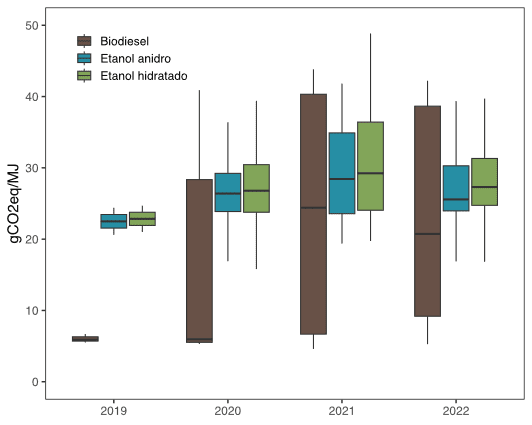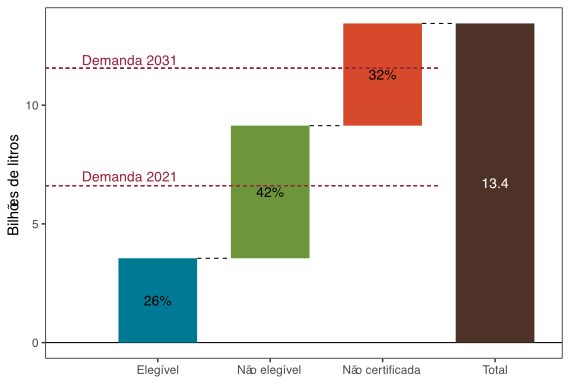Oportunidades e riscos para a expansão continuada dos biocombustíveis no Brasil
Blog
O impacto ambiental de biocombustíveis no Brasil: O que ficou de fora?
Em dezembro de 2022 a Empresa de Pesquisa Energética publicou a nota técnica “Descarbonização do Setor de Transporte Rodoviário – Intensidade de carbono das fontes de energia”. O estudo quantifica a intensidade de carbono do ciclo de vida das fontes energéticas utilizadas no setor de transporte rodoviário nacional. Notícias recentes indicam que as próximas metas de eficiência energética dos veículos nacionais serão definidas em emissões de carbono (CO2/km) e não mais em energia (MJ/km). Portanto, as intensidades de carbono determinadas no estudo podem nortear as novas metas de redução de emissões da frota brasileira.
O estudo da EPE projeta ainda reduções significativas das intensidades de carbono dos biocombustíveis até 2032 devido à aperfeiçoamentos no processo produtivo e à maior difusão da certificação de biomassa. Contudo, algumas premissas adotadas podem subestimar a intensidade de carbono da produção de etanol e, principalmente, de biodiesel.
A produção nacional de biocombustíveis é diversa e suas emissões dependem fundamentalmente das biomassas utilizadas, da certificação de seus locais de origem, dos insumos agrícolas utilizados, distâncias transportadas e da intensidade energética dos processos industriais. Portanto, a determinação de um valor único para a intensidade de carbono do biodiesel ou etanol acarreta riscos intrínsecos e pode motivar a utilização de biomassas com maior impacto ambiental.
Melhorias no processo produtivo?
As reduções das intensidades de carbono projetadas no estudo são, ao menos parcialmente, atribuídas a melhoras no processo produtivo. No entanto, cenários de expansão da produção de etanol preveem um acréscimo máximo de apenas 14 novas usinas na próxima década, frente a 277 usinas certificadas em junho de 2022. Para a produção de biodiesel, a capacidade instalada atual já é capaz de suprir a demanda nacional estimada para 2031 (ver Figura 2). Portanto, as reduções projetadas das intensidades de carbono dependerão fundamentalmente de aperfeiçoamentos nas plantas ativas, da ampliação do rastreamento na produção de soja e de aumentos na proporção de biomassas com menores fatores de emissão, como resíduos, no mix produtivo.
Boa parte das emissões do ciclo de vida dos biocombustíveis depende dos insumos utilizados na fase agrícola. Caso estes dados não estejam disponíveis, as certificações utilizam os valores padrões penalizados (maiores) do programa RenovaBio para as emissões ligadas a insumos agrícolas e transporte. As certificações do programa RenovaBio, entre 2019 e 2022, nos permitem observar tendências nas emissões dos biocombustíveis nacionais. A Figura 1, abaixo, apresenta box-plots das intensidades de carbono de biodiesel e etanol.
Apesar de constituir um programa robusto e certificar a maior parte da produção nacional de etanol, não há uma tendência clara de redução das emissões desde 2019. Nas certificações de biodiesel, observa-se um aumento das emissões (medianas) até 2021 seguida de uma ligeira redução no primeiro semestre de 2022, porém com grande variabilidade devido à diversidade de biomassas utilizadas. A trajetória das emissões de etanol é parecida, porém com menor variabilidade. Isto posto, torna-se ainda mais importante uma discussão detalhada das hipóteses e ações que possibilitarão reduções futuras das emissões associadas aos biocombustíveis.

Figura 1. Boxplot das intensidades de carbono, de etanol anidro, hidratado e biodiesel, no programa RenovaBio, por ano de certificação. (g CO2eq/MJ) Fonte: ANP e ANP. As linhas dentro dos retângulos nos box-plots indicam as medianas, os limites inferiores e superiores dos mesmos indicam o primeiro e o terceiro quartil, respectivamente. As linhas abaixo e acima dos retângulos indicam as observações mínimas e máximas, excluindo outliers. Número de certificações de etanol (anidro e hidratado): 4 em 2019, 280 em 2020, 109 em 2021 e 72 em 2022; e de Biodiesel: 3 em 2019, 6 em 2020, 12 em 2021 e 11 em 2022
Emissões de biocombustíveis não elegíveis ao programa RenovaBio
As intensidades de carbono apresentadas no estudo da EPE devem expressar valores representativos nacionais, considerando que parte da produção não é elegível ao programa RenovaBio. O critério mínimo de elegibilidade do programa é a comprovação de que a biomassa energética tem origem em um imóvel com Cadastro Ambiental Rural (CAR), ativo ou pendente, no qual não se verificou supressão de vegetação nativa, na área plantada, desde 2017. Atualmente uma parcela significativa da produção nacional de biodiesel não cumpre estes requisitos mínimos.
Utilizando dados da capacidade produtiva das usinas de etanol e biodiesel e o percentual elegível da produção em cada certificação do RenovaBio, podemos calcular a parcela da capacidade produtiva nacional não incluída no programa. A figura 2 demonstra que apenas 26% da capacidade produtiva nacional é elegível. Usinas certificadas contém 68% desta capacidade. Os 32% restantes estão associados a usinas não certificadas. No caso do etanol anidro e hidratado, os percentuais da capacidade elegíveis são muito mais altos, de 82% e 73%, respectivamente.

Figura 2. Capacidade produtiva de Biodiesel por status de elegibilidade e certificação no programa RenovaBio (Bilhões de litros). Fonte: ANP, ANP e EPE. Capacidade produtiva em é convertido para litros transformando metros cúbicos em litros (x1000) e considerando 365 dias de produção. As demandas obrigatórias para 2021 e projetada para 2031 foram obtidas em EPE.
Na tabela 1, a seguir, comparamos as intensidades de carbono dos biocombustíveis no estudo da EPE com as médias das certificações do RenovaBio e com médias ponderadas que consideram também a capacidade não elegível. Para tanto, assumimos uma hipótese conservadora de que a produção não elegível tem uma intensidade de carbono igual à pior produção elegível.
Tabela 1. Comparação entre intensidades de carbono dos biocombustíveis na Nota Técnica da EPE, no programa RenovaBio, e incluindo a capacidade não elegível (gCO2/MJ).
| Etanol hidratado | Etanol anidro | Biodiesel | |
| NT (EPE) | 28.5 | 26.9 | 24.0 |
| RenovaBio | 27.5 | 26.9 | 20.1 |
| Diferença % | -4% | 0% | -17% |
| Renovabio + capacidade não elegível | 33.2 | 32.0 | 37.6 |
| Diferença % | 17% | 19% | 56% |
Fonte: ANP e ANP. As médias calculadas para o programa RenovaBio são ponderadas pela capacidade produtiva e volume elegível das intensidades de carbono certificadas no programa. A média ponderada RenovaBio + capacidade não elegível atribui as maiores intensidades de carbono certificadas no programa RenovaBio, de 58,66, 45,71 e 43,88 gCO2/MJ para etanol hidratado, anidro e biodiesel, respectivamente, à capacidade não elegível e a média do programa RenovaBio à capacidade elegível.
As intensidades de carbono definidas no estudo da EPE são ligeiramente superiores às médias do programa RenovaBio e significativamente menores do que as médias ponderadas com capacidade não elegível. Sem novos incentivos para reduzir a produção a partir de culturas que podem ser armazenadas e transportadas com facilidade, como a soja e o milho, esperar um aumento da elegibilidade e certificação da biomassa pode ser demasiado otimista.
Emissões do uso da terra
Os valores apresentados no estudo da EPE não consideram emissões de uso direto (LUC) ou indireto da terra (ILUC). Emissões ILUC ocorrem quando a demanda de biocombustível gera o aumento da área cultivada de biomassa energética, substituindo outras culturas que, por sua vez, se deslocam para novas terras suprimindo vegetação nativa. A presença de uma significativa capacidade produtiva não elegível de biodiesel reforça o risco de emissões ILUC.
O RenovaBio procura mitigar o potencial de desmatamento atrelado aos biocombustíveis aceitando apenas biomassas de propriedades incluídas no Cadastro Ambiental Rural (CAR). No entanto, este critério de não desmatamento aplica-se exclusivamente à área do imóvel dedicada ao plantio. Portanto, até mesmo imóveis rurais habilitados a fornecer biomassa podem ter áreas de vegetação nativa desmatada, se esta não for a área de plantio da biomassa. Não podemos, então, descartar o risco de que áreas elegíveis do RenovaBio estejam associadas a emissões indiretas do uso da terra (ILUC).
Apesar das conhecidas dificuldades envolvidas no cálculo de emissões ILUC, existem hoje medidas reconhecidas internacionalmente específicas para os biocombustíveis brasileiros. A Organização da Aviação Civil Internacional estima emissões ILUC de 8,7 para a cana-de-açúcar brasileira que, se somados as intensidades de carbono do RenovaBio, aumentariam as emissões do ciclo de vida em cerca de 30%. A California Air Resource Board, ao considerar emissões ILUC, calcula emissões médias de 48,1 para o etanol nacional, cerca de 70% maiores do que no RenovaBio.
Apesar das dificuldades metodológicas envolvidas no cálculo e implementação de emissões do uso da terra, acreditamos que seja necessário discutir a possibilidade de contabilizá-las. Ao ignorar a possível conexão com emissões do uso da terra, as intensidades de carbono apresentadas no estudo da EPE não consideram este risco e podem não refletir o impacto ambiental da produção nacional. Em particular, no caso do biodiesel, a contabilização de emissões ILUC na fase agrícola funcionaria como um incentivo a insumos alternativos e de menor impacto ambiental.
Os argumentos acima questionam algumas das hipóteses adotadas no estudo da EPE para calcular as emissões do ciclo de vida dos biocombustíveis nacionais. As projeções apresentadas no estudo da EPE podem superestimar as reduções nas intensidades de carbono dos biocombustíveis, principalmente no caso do biodiesel. Em particular, o aumento das certificações agrícolas e a ampliação do uso de biomassas com menores impacto ambiental, como resíduos, parecem improváveis sem novos incentivos. Destaca-se que os cálculos desconsideram riscos relacionados a emissões do uso da terra e podem assim incentivar a produção de biodiesel ligado a emissões de uso indireto da terra, assim comprometendo a meta do governo de zerar o desmatamento em todos os biomas nacionais.
